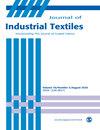Polydopamine-mediated in situ synthesis of gold nanoparticles uniformly distributed on silk fibers as reusable catalysts for efficient 4-nitrophenol reduction
IF 2
4区 工程技术
Q1 MATERIALS SCIENCE, TEXTILES
引用次数: 0
Abstract
Developing green fibrous materials with uniformly distributed metal nanoparticles for highly efficient and recyclable catalysis remains a major challenge. Herein, we developed a simple, effective, and green method to immobilize gold nanoparticles (AuNPs) on polydopamine (PDA)-functionalized silk fibers (SFs) for efficient catalytic reduction of 4-nitrophenol (4-NP). The density and size of AuNPs on the PDA-coated SFs can be tuned by adjusting precursor concentration and synthesis duration, respectively. The AuNPs-PDA-SFs catalysts prepared under optimized conditions could catalyze the reduction of 4-NP, 4-nitroaniline (4-NA), and 4-amino-3-nitrophenol (4-A-3-NP) at the apparent rate constants of 0.087, 0.091, and 0.063 min聚多巴胺介导的原位合成均匀分布在丝纤维上的金纳米粒子,作为可重复使用的催化剂用于高效还原 4-硝基苯酚
开发具有均匀分布的金属纳米颗粒的绿色纤维材料以实现高效和可回收催化仍然是一项重大挑战。在此,我们开发了一种简单、有效、绿色的方法,将金纳米颗粒(AuNPs)固定在多巴胺(PDA)功能化的丝纤维(SFs)上,用于高效催化还原 4-硝基苯酚(4-NP)。通过调节前驱体浓度和合成时间,可分别调整 PDA 涂层 SFs 上 AuNPs 的密度和大小。在优化条件下制备的 AuNPs-PDA-SFs 催化剂可催化还原 4-NP、4-硝基苯胺(4-NA)和 4-氨基-3-硝基苯酚(4-A-3-NP),表观速率常数分别为 0.087、0.091 和 0.063 min-1。在对 4-NP 进行六轮流动还原后,AuNPs-PDA-SFs 的 4-NP 转化率仍能保持在 92% 以上,这表明它们具有优越的重复使用性和稳定的催化活性。由于 SFs 的蛋白质特性,AuNPs-PDA-SFs 可被酶和碱溶液降解。这项工作可为设计具有高催化性能和可重复使用性的先进纤维支撑可回收催化剂提供新的启示。
本文章由计算机程序翻译,如有差异,请以英文原文为准。
求助全文
约1分钟内获得全文
求助全文
来源期刊

Journal of Industrial Textiles
MATERIALS SCIENCE, TEXTILES-
CiteScore
5.30
自引率
18.80%
发文量
165
审稿时长
2.3 months
期刊介绍:
The Journal of Industrial Textiles is the only peer reviewed journal devoted exclusively to technology, processing, methodology, modelling and applications in technical textiles, nonwovens, coated and laminated fabrics, textile composites and nanofibers.
文献相关原料
公司名称
产品信息
阿拉丁
papain
阿拉丁
4-nitroaniline
阿拉丁
4-amino-3-nitrophenol
阿拉丁
sodium hydroxide (NaOH)
阿拉丁
4-nitrophenol (4-NP)
阿拉丁
chloroauric acid (HAuCl4)
阿拉丁
dopamine hydrochloride (DA)
阿拉丁
Sodium borohydride (NaBH4)
 求助内容:
求助内容: 应助结果提醒方式:
应助结果提醒方式:


